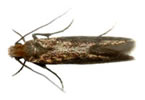
Common Pests – Moths
Textile or Clothing moth
Brown Tail moth
Description
The Textile, or Clothing Moth is a small, thin moth, with mottled brown colouration. The larval phase of the textile moth is usually a cream/white coloured caterpillar with a dark coloured head.
The Brown Tail Moth has white wings, which measure 32-33 mm (1.3″ – 1.5″) across, a white head and thorax, with a dark brown abdomen which has a tuft of brown hairs at the tip. Its larvae, or caterpillars, when ready to pupate in June, can be up to 25 mm/1″ in length. The body is nearly black with two bright orange marks on the rear (abdominal) segments, which also have a row of downy white scales along the upper part of each side. The body has long yellowish brown hairs in tufts.
Lifecycle and Habits
There are many species of Textile or Clothing moths common to the UK. They are mostly found in natural products of animal origin (eg woven fibres, fur, wool, feather products, woven fabrics etc.) It is the larvae of this pest that causes damage to materials. These can develop in large numbers, in the right conditions, as the adult female can lay up to 160 eggs during a period of 2-3 weeks. The larvae spins itself a “feeding tunnel”, made from silk, that serves as a home during its development. It may be possible to detect these fibres of silk or moth waste (“Frass”), woven in among the fibres of carpet areas, etc. This may provide an indication as to where treatment is required. Both adults and larvae prefer low light conditions. Whereas most other moths are drawn to light, clothing moths seem to prefer dim or dark areas. If larvae find themselves in a well-lit room, they will try to relocate under furniture or carpet edges. Hand made rugs are a favorite because it is easy for them to crawl underneath and do their damage from below. They will also crawl under moldings at the edges of rooms in search of darkened areas which hold good food.
The Brown Tail Moth may be seen in July and August. They lay eggs from which hatch the larvae. They may be seen August to October, then again after winter hibernation, from April to June. The caterpillars spin a silken home or tent which they gradually enlarge. These can be seen on plants as white silken bags which may be connected by white silken ‘walkways’ along branches.
What Moths Eat
Adult Textile or Clothing moths do not eat. It is the larvae that feed on clothing and natural fibers; they have the ability to turn keratin, a protein, into food. They prefer dirty fabric and are particularly attracted to carpeting and clothing that contain human sweat or other liquids which have been spilled onto them. They are attracted to these areas not for the food but for the moisture. Moth larvae do not drink water; consequently their food must contain moisture. The larvae of the Brown Tail moth are found on shrubs and trees including Blackthorn, Bramble, Dog Rose, Hawthorn, Apple, Pear, Plum and Elm. Forsythia, Oak and Strawberry may also be infested.
Problems Linked to Moths
Textile, or Clothing moth larvae can cause physical damage to carpets and other textiles. However, they are not seen as a significant risk to health.
The larvae of the Brown Tail Moth should not be allowed to come into contact with the skin. The hairs have a poison gland at the base and a rash can be produced which may be severe in some people. Similarly, the hairs could produce severe damage were they to enter the eye. Do not handle larvae even when they are dead. Bury or burn them.
Preventing or dealing with an infestation
It is important to avoid conditions suitable for Textile or Clothing moths.
a) Keep all wardrobes and clothing areas aired.
b) All affected clothing should be thoroughly cleaned.
c) Regular inspections of clothing should be done, looking for holes or larvae.
d) Frequent use of a vacuum cleaner, in wardrobes, storage cupboards and on carpets can also help to reduce population numbers. After using a vacuum, remove the collection bag and dispose of in an outside bin.
e) Clothes, fabrics, and linens that are not in regular use, should be stored in a sealed bag or wrapped in plastic.
When looking for an insecticide, make sure that it is designed to deal with moths and that it has a long lasting killing effect. This may be applied to cracks, crevices, gaps in floorboards, onto affected carpet areas and in wardrobe or cupboard spaces. There are also “vaporising strips” that are available on the market, these are designed specifically for use in enclosed spaces (eg wardrobes, cupboards etc.) You may need to repeat treatment a number of times before the problem can be cleared. If using an insecticide, always follow the instructions.
The silken tents containing the Brown Tail Moth caterpillars can be cut out from the foliage and burnt or buried. Whilst inside the tents the caterpillars are difficult to reach with insecticides. Spraying can be effective using specialist insecticides available from garden centers. If using insecticides, always follow the instructions.
Professional help
It may be advisable to contact a reputable Pest Control company, either for advice, or to carry out a professional treatment. The British Pest Control Association has a list of its member companies on its website, for all areas.